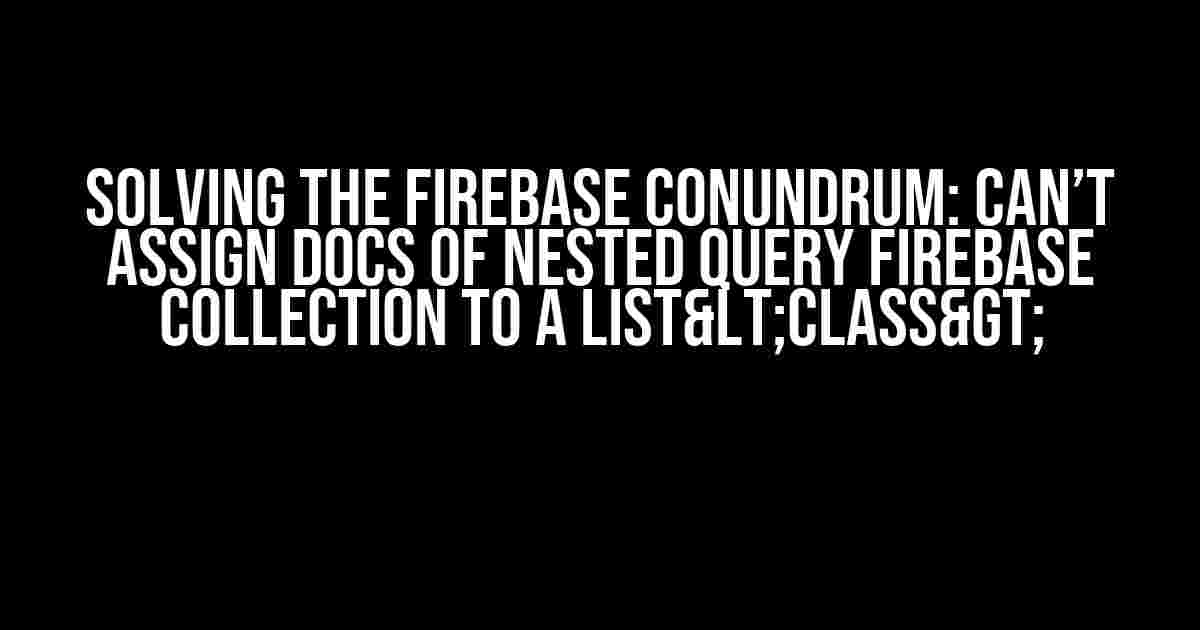Ah, the frustration of dealing with Firebase collections! You’ve finally mastered the art of querying and fetching data, only to be slapped in the face with an error message that reads: “Can’t assign docs of nested query Firebase collection to a List<class>”. Don’t worry, friend, you’re not alone in this struggle. In this article, we’ll dive deep into the world of Firebase and explore the reasons behind this pesky error, as well as provide a step-by-step guide on how to overcome it.
The Problem: A Closer Look
Before we dive into the solution, let’s take a closer look at the problem. The error message is quite straightforward: you’re trying to assign the result of a nested query to a List of a specific class. But why is this a problem? Well, it all boils down to the way Firebase handles data retrieval.
Firebase Data Retrieval 101
Firebase is a NoSQL database, which means it stores data in a hierarchical structure, rather than the traditional table-based approach of relational databases. This structure is comprised of collections, documents, and fields. Collections are essentially containers that hold multiple documents, which are the individual units of data. Each document, in turn, contains fields, which are key-value pairs.
When you query a Firebase collection, you’re essentially asking the database to retrieve a subset of documents that match your query criteria. The result of this query is a Firebase Querysnapshot, which contains a list of documents that match your query.
The Issue: Firebase Querysnapshot vs. List<class>
The root of the problem lies in the fact that a Firebase Querysnapshot is not directly assignable to a List of a specific class. This is because a Querysnapshot is a Firebase-specific object that contains a list of documents, whereas a List is a .NET collection that expects a specific type.
To illustrate this, let’s consider an example:
// Suppose we have a class called 'User'
public class User {
public string Name { get; set; }
public int Age { get; set; }
}
// We query a Firebase collection called 'users'
FirebaseFirestore db = FirebaseFirestore.GetInstance();
CollectionReference usersCollection = db.Collection("users");
// We want to retrieve all users who are older than 18
Query query = usersCollection.WhereEqualTo("Age", 18);
// We execute the query and get a Querysnapshot
QuerySnapshot snapshot = query.GetSnapshotAsync().Result;
// Now, we try to assign the snapshot to a List of Users
List<User> users = snapshot.Documents.ToList(); // This won't work!
As we can see, the compiler will throw an error, complaining that it can’t assign the Querysnapshot to a List of Users. This is because the Querysnapshot contains a list of documents, which are not directly convertible to our User class.
The Solution: Convert Firestore Documents to .NET Objects
So, how do we overcome this hurdle? The solution lies in converting each Firestore document to an instance of our User class. We can do this by creating a method that takes a Firestore document as input and returns an instance of our User class.
// Create a method to convert Firestore documents to User objects
public static User ConvertDocumentToUser(DocumentSnapshot document) {
User user = new User {
Name = document.Get("Name").ToString(),
Age = int.Parse(document.Get("Age").ToString())
};
return user;
}
With this method in place, we can now assign the Querysnapshot to a List of Users like this:
// Assign the Querysnapshot to a List of Users
List<User> users = snapshot.Documents.Select(document => ConvertDocumentToUser(document)).ToList();
Optimizing the Solution: Using AutoMapper
While our previous solution works, it can become cumbersome to write conversion methods for each class. This is where AutoMapper comes to the rescue. AutoMapper is a popular library that allows you to map objects from one type to another.
We can use AutoMapper to simplify our conversion process by creating a mapping configuration for our User class:
// Create a mapping configuration for the User class
MapperConfiguration config = new MapperConfiguration(cfg => {
cfg.CreateMap<DocumentSnapshot, User>()
.ForMember(dest => dest.Name, opt => opt.MapFrom(src => src.Get("Name").ToString()))
.ForMember(dest => dest.Age, opt => opt.MapFrom(src => int.Parse(src.Get("Age").ToString())));
});
// Create an instance of the mapper
IMapper mapper = config.CreateMapper();
With the mapper in place, we can now convert the Querysnapshot to a List of Users like this:
// Assign the Querysnapshot to a List of Users using AutoMapper
List<User> users = snapshot.Documents.Select(document => mapper.Map<User>(document)).ToList();
By using AutoMapper, we’ve simplified the conversion process and made our code more maintainable.
Conclusion
In conclusion, the error message “Can’t assign docs of nested query Firebase collection to a List<class>” is a common pitfall when working with Firebase collections in .NET. By understanding the difference between a Firebase Querysnapshot and a .NET List, we can convert Firestore documents to .NET objects using either manual conversion methods or AutoMapper. By following the steps outlined in this article, you’ll be well on your way to mastering Firebase data retrieval and manipulation in .NET.
Best Practices
- Always use AutoMapper to simplify the conversion process and make your code more maintainable.
- Use strongly-typed models to define your Firestore documents, making it easier to convert them to .NET objects.
- Keep your Firestore collection and document structures consistent to avoid complexities during data retrieval.
| Firebase Collection | .NET Class |
|---|---|
| users | User |
| products | Product |
By following these best practices and understanding the nuances of Firebase data retrieval, you’ll be able to tackle even the most complex data manipulation tasks with ease.
Frequently Asked Questions
-
Q: What is a Firebase Querysnapshot?
A: A Firebase Querysnapshot is an object that contains a list of documents that match a specific query criteria.
-
Q: Why can’t I assign a Querysnapshot to a List<class>?
A: Because a Querysnapshot contains a list of documents, which are not directly convertible to a .NET class.
-
Q: What is AutoMapper?
A: AutoMapper is a popular library that allows you to map objects from one type to another, simplifying the conversion process.
We hope this article has helped you overcome the hurdle of assigning a Querysnapshot to a List of a specific class. If you have any further questions or need more assistance, feel free to ask!
Here is the FAQ section about “can’t assign docs of nested query Firebase collection to a List
Frequently Asked Question
Get the answers to your burning questions about Firebase collections!
Why can’t I assign documents from a nested query to a List of a specific class?
When you retrieve documents from a Firebase collection using a nested query, the resulting documents are not strongly typed, which means they don’t conform to a specific class or type. To fix this, you need to manually map the documents to your class or use a library like FirebaseUI to simplify the process.
What is the purpose of using a List of a specific class in Firebase?
Using a List of a specific class in Firebase allows you to leverage strong typing and take advantage of code completion, compile-time checks, and auto-generated getters and setters. This leads to more maintainable, readable, and efficient code. It’s especially useful when working with complex data models.
How do I map documents from a Firebase collection to a specific class?
You can map documents to a specific class by manually creating an instance of the class and populating its properties with the document data. Alternatively, you can use libraries like FirebaseUI or Firestore-Dart to simplify the process and automate the mapping for you.
What are the benefits of using a library like FirebaseUI or Firestore-Dart?
Using a library like FirebaseUI or Firestore-Dart can simplify your code, reduce boilerplate, and provide additional features like automatic data serialization, deserialization, and caching. These libraries can also help you handle complex data models and relationships, making it easier to work with Firebase collections.
Can I use Firebase’s built-in `toObject()` method to convert a document to a specific class?
Yes, you can use Firebase’s built-in `toObject()` method to convert a document to a specific class. However, this method only works if the class has a zero-argument constructor and public getters and setters for each field. Additionally, the class must have the same property names as the document fields. If your class has complex logic or requires additional processing, manual mapping or using a library might be a better approach.
I hope this helps! 😊


